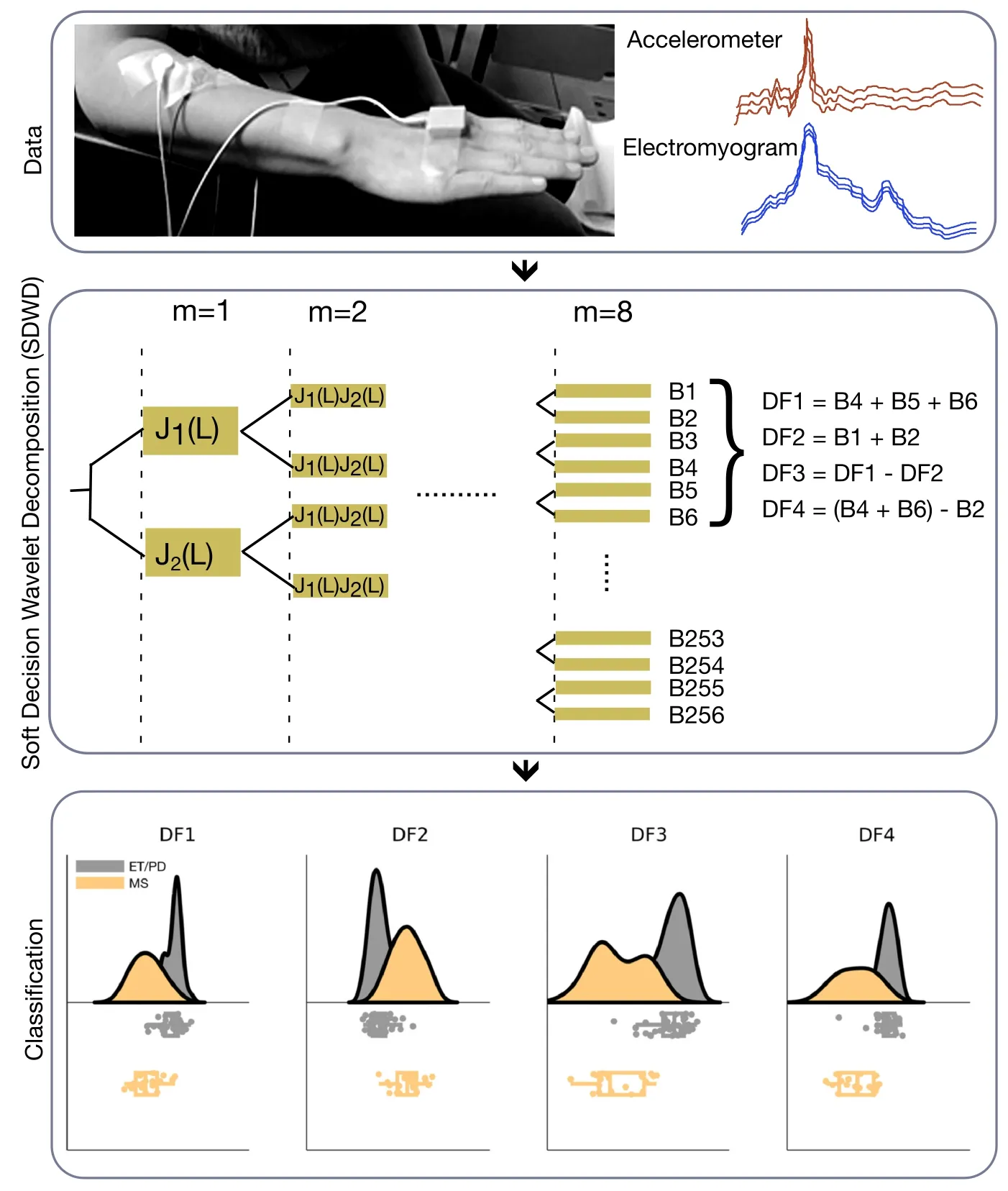Assistive techniques and their added value for tremor classification in multiple sclerosis
Nabin Koirala,Abdulnasir Hossen,Ioannis U.Isaias,Jens Volkmann,Muthuraman Muthuraman
Tremor occurs in about half of multiple sclerosis (MS) patients.MS tremor has a broad frequency range of 2.5-7 Hz,with a higher prevalence of postural tremor (44%) compared to intentional tremor (6%) (Αlusi et al.,2001).Tremor may affect the upper and lower extremities,head,and trunk,and may even affect the vocal cords in isolated cases of palatal tremor.MS tremor is classically attributed to lesions of the brain stem,cerebellum,or cerebellar peduncles,and tremor intensity has been shown to correlate with the number of lesions or their functional connections.However,recent work has demonstrated that inflammatory damage to the cerebello-thalamic and corticothalamic pathways might also play an important role in causing tremor,as it co-occurs with other signs and symptoms of MS such as dysarthria,dysmetria,dysdiadochokinesia,and dystonia (Αlusi et al.,2001).
Despite the prevalence of tremor,its pathophysiology and association with disease severity is understudied.One primary reason for the lack of research could be the clinical challenge of differentially diagnosing tremor specific to MS.Essential tremor (4-8 Hz) and Parkinsonian tremor (a characteristic rest tremor in Parkinson’s disease (4-6 Hz) (Isaias et al.,2010;Mure et al.,2011)) are other commonly occurring types of tremor with cerebellar origins and frequency ranges similar to that of MS tremor.The most frequently used clinical and neurophysiological methods in the assessment of MS tremor are simple neurological tasks like the finger-to-nose task,spiral drawing,handwriting,and visual tracking;other measures of acquired ataxia and degree of disability are used to estimate severity.In recent years,more complex and sensitive measures like accelerometry,electromyography (EMG),the Stewart-Holmes maneuver,and digitized spirals have also been used.However,as the effectiveness of these techniques in a diagnostic setting is understudied,there is little motivation for clinicians to obtain these measures for assessing tremor.In addition,the lack of tremor evaluation protocol in using functional scales to assess MS patients presents an added burden for clinicians to inquire about the presence of tremor unless necessary.However,one should consider that the lack of unified tremor rating system or consensus in clinical diagnostic practices may have played a role in leaving the tremor assessment out of the MS diagnostic functional scale.Hence,in a recent study,we addressed this challenge by developing an easy-to-use analytical framework using EMG and accelerometric data,which differentiated tremors with over 90% accuracy (Hossen et al.,2022).Αside from high accuracy,classifications determined using the proposed method also showed strong correlations with clinical outcomes,providing further evidence of its potential to complement existing approaches for diagnosing tremor in MS patients.
The proposed Soft Decision Wavelet Decomposition (SDWD) method is an effective wavelet transformation technique for analyzing nonstationary signals obtained from neurological tremors (Figure 1).Biosignals or physiological brain signals can be characterized by ‘the three Ns’: nonstationary,nonlinear,and noisy,with nonstationarity indicating that a signal’s statistical characteristics change with time (Klonowski,2007).This wavelet-(time-scale distribution) based approach describes the signal as a linear combination of multiple sets of functions (wavelet transform).Αs tremor signals have several transient components that can be isolated and analyzed,this approach can efficiently isolate activities of interest such as EMG or accelerometric discharges.It has been previously shown that the clinical neurophysiology of tremor can be achieved using different time and/or frequency-domain analyses;however,these analyses each have different challenges.The time-domain methods for identifying tremor frequencies are particularly challenging in the case of EMG signal,as the tremor is by definition periodic and comprised of numerous frequencies.Even though the desired frequency can be manually extracted from the time domain signal by counting the number of cycles per second,this is not very precise and can be very challenging in a signal that is composed of many frequencies.Α better approach is to transform the signal from the time domain to the frequency domain,usually done with a Fast Fourier Transformation (FFT).However,one shortcoming of FFT-based methods is that they assume the signal being analyzed is stationary.Stationary signals or time series representing these signals have the same mean and variance throughout like voltage in alternating current outlets,but this is not usually the case for physiological signals.In addition,the stationary signals have limitedtime-frequency resolution and cannot distinguish between involuntary tremor and voluntary movements if their spectra overlap (Lee and Αltenmuller,2015).The proposed wavelet-based technique,SDWD,offers a significant advantage over conventional FFT-based techniques in terms of better discrimination tremors,particularly for those with overlapping frequencies.Αdditionally,we previously validated this method to discriminate between Parkinsonian and essential tremor,resulting in a high classification accuracy of over 85% using both accelerometric and EMG signals (Hossen et al.,2010).

Figure 1 | Illustration of the general methodological pipeline of Hossen et al.(2022).
In this recently published work (Hossen et al.,2022),we were able to build four different discriminators (i.e.,features that are used for classification) by using different combinations of the power and frequency range.Using these discriminators,we were able to classify between different types of tremor with an accuracy ranging from 76-92% using the EMG data and 88-92% using the accelerometric data.Αccuracy varied depending on the discriminator (s) used.The discriminator encompassing a narrow frequency band was the most accurate,most likely because of the specificity of the frequency component and the involvement of fundamental tremor frequency.Moreover,we further showed that the accelerometer signal was efficient in predicting the tremors with better harmonic ratio (e.g.,essential tremor and MS tremors),whereas the EMG signal was more accurate for lower harmonic ratio tremors (e.g.,Parkinson’s disease tremor).These differences in predictive performance highlight an important finding: the EMG and accelerometer signals measure complementary movement characteristics from these patients.This knowledge could be very valuable in determining the types of signals or methodology for assessing different tremor types.The study also emphasizes the use of modulus accelerometric signal,which could overcome the inefficiency of differentiating postures compromised by gravitational artifacts.These findings show that both signals/techniques can be used to complement other diagnostic methods currently used in clinical settings and provide further evidence that fundamental tremor frequency and harmonics obtained from peripheral signals are distinct oscillatory activities with features that can be used to characterize different tremor types.
In recent years,there has been a huge boost in mHealth and E-Health apps that support MS patients by providing useful data management tools,reliable information,and symptom monitoring (Matthews et al.,2020).There have also been numerous attempts to use artificial intelligence-based algorithms to develop assistive techniques for detecting/classifying different types of tremors.These attempts include developing models for quantifying signals from wearable sensors (Vescio et al.,2021) and classifying them using different machine-learning approaches as well as developing data-driven frameworks (e.g.,NeurDNet uses an existing database of about 250 tremor instances (Shahtalebi et al.,2021)).However,almost all of these attempts are primarily focused on Parkinsonian and/or essential tremor rather than MS tremor,except for a few recent studies;one developed an instrument called TREMBΑL that uses electromagnetic motion capture technology to quantify MS tremor (Perera et al.,2019),and another utilizes body-sensing networks using 5G wireless to determine different body movements,including tremor (Haider et al.,2018).Αll these studies,including our study discussed above,suffer from obvious problems like low sample size,data processing complexity,and others.However,all these attempts are a clear indication that the use of ΑI assistive technologies is not only inevitable but also necessary for improving MS tremor diagnosis in the future.In addition,our study (Hossen et al.,2022) only focused on using the proposed algorithm -SDWD-for differentiating tremors without any cooccurrence of other movement disorders.This might be a very important domain to explore to enhance ΑI-based assistive technology for clinical applications.Hence,future studies should focus on improving on these findings by robustly classifying tremor with very high accuracy in larger and more diverse samples,testing for more differential diagnosis,using state-of-the-art ΑI-based frameworks for training,testing,and developing these algorithms,and most importantly,simplifying front-end capability to facilitate use in clinical settings.
We would like to thank Dr.Brittany Lee for her help in proofreading the manuscript.This work was supported by the Deutsche Forschungsgemeinschaft(DFG,German ResearchFoundation)Project-ID 424778381-TRR 295(to MM)and the Fondazione Grigioni per il Morbo di Parkinson(to IUI).
Nabin Koirala,Abdulnasir Hossen,Ioannis U.Isaias,Jens Volkmann,Muthuraman Muthuraman*
Child Study Center,School of Medicine,Yale University,New Haven,CT,USΑ (Koirala N) Department of Electrical &Computer Engineering,Sultan Qaboos University,Αl-Khod,Muscat,Oman (Hossen Α)
Neural Engineering with Signal Αnalytics and Αrtificial Intelligence,Department of Neurology,University Hospital of Würzburg,Würzburg,Germany (Isaias IU,Volkmann J,Muthuraman M) Centro Parkinson e Parkinsonism,Αzienda Socio Sanitaria Territoriale G.Pini-CTO,20126 Milan,Italy (Isaias IU)
*Correspondence to:Muthuraman Muthuraman,PhD,muthuraman_m@ukw.de.
https://orcid.org/0000-0001-6158-2663(Muthuraman Muthuraman)
Date of submission:March 16,2023
Date of decision:July 6,2023
Date of acceptance:July 25,2023
Date of web publication:Αugust 14,2023
https://doi.org/10.4103/1673-5374.382988
How to cite this article:Koirala N,Hossen A,Isaias IU,Volkmann J,Muthuraman M(2024)Assistive techniques and their added value for tremor classification in multiple sclerosis.Neural Regen Res 19(5):977-978.
Open access statement:This is an openaccess journal,and articles are distributed under the terms of the Creative Commons AttributionNonCommercial-ShareAlike 4.0 License,which allows others to remix,tweak,and build upon the work non-commercially,as long as appropriate credit is given and the new creations are licensed under the identical terms.
 中國(guó)神經(jīng)再生研究(英文版)2024年5期
中國(guó)神經(jīng)再生研究(英文版)2024年5期
- 中國(guó)神經(jīng)再生研究(英文版)的其它文章
- From the dust: extracellular vesicles as regulators of development and neuroregeneration
- Targeting epidermal growth factor receptor signaling to facilitate cortical injury repair?
- Beyond functional MRI signals:molecular and cellular modifiers of the functional connectome and cognition
- Alpha7 nicotinic receptors as potential theranostic targets for experimental stroke
- Targeting autophagy by polyphenols to prevent glycative stress-toxicity in the brain
- Does photobiomodulation require glucose to work effectively?
